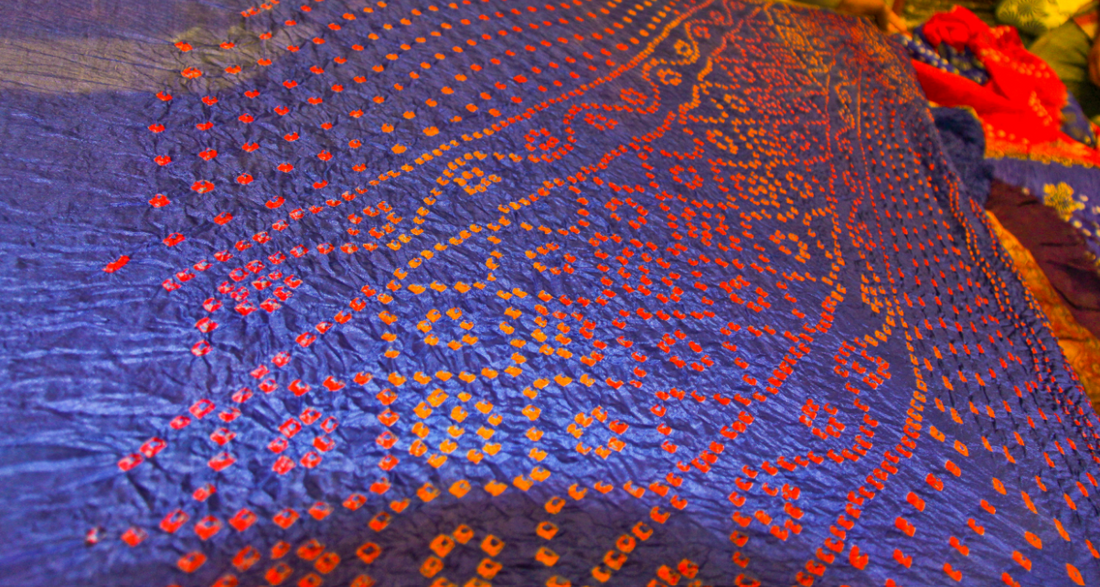Embark on a journey into the vibrant world of Bandhani Silk Sarees, where the art of tying tiny knots meets the luxurious embrace of silk. Rooted in the cultural heritage of India, Bandhani Silk Sarees are a testament to the meticulous craftsmanship and timeless beauty that continue to capture the hearts of saree enthusiasts. In this exploration, we unravel the intricate details of Bandhani Silk Sarees, tracing their origins, understanding their appeal, and celebrating the rich traditions they carry.
What is a Bandhani Silk Saree?
Bandhani, derived from the Sanskrit word 'bandh,' meaning 'to tie,' is a traditional Indian tie-and-dye technique that involves tying small portions of the fabric with thread and then dyeing it to create vibrant patterns. Bandhani Silk Sarees, therefore, are silk sarees adorned with these intricate, tie-dye designs, reflecting the rich textile traditions of India.
When Did the Legacy Begin?
The art of Bandhani has ancient roots, dating back over centuries. It is believed to have originated in the regions of present-day Gujarat and Rajasthan, where artisans mastered the delicate skill of creating patterns through the resist-dyeing method. Over time, Bandhani has become synonymous with celebrations and festivities in various parts of India.
Where Are Bandhani Silk Sarees Woven?
Bandhani Silk Sarees are crafted primarily in the states of Gujarat and Rajasthan, where the Bandhani technique has been passed down through generations. The towns of Jamnagar, Bhuj, and Jaipur are renowned for their Bandhani craftsmanship, and each region contributes its unique styles and patterns to the art form.
Who Adorns Bandhani Silk Sarees?
Bandhani Silk Sarees are cherished by women across India, especially during special occasions and festivals. The vibrant colors and intricate patterns make them a popular choice for weddings, celebrations, and cultural events. The sarees hold cultural significance and are often passed down as heirlooms, symbolizing tradition and artistry.
Why Choose Bandhani Silk Saree?
- Artistic Appeal: The tie-and-dye technique of Bandhani creates mesmerizing patterns on the silk fabric, making each saree a piece of wearable art.
- Versatility: Bandhani Silk Sarees come in a wide array of colors and designs, catering to different tastes and preferences. The versatility of these sarees makes them suitable for various occasions.
- Cultural Significance: Bandhani is deeply embedded in the cultural tapestry of India. Wearing a Bandhani Silk Saree is not just a fashion choice but a celebration of tradition and craftsmanship.
- Luxurious Silk: The use of silk fabric adds a touch of luxury to Bandhani sarees. The smooth texture of silk enhances the overall appeal, making it a comfortable and elegant choice.
- Symbol of Celebration: Bandhani Silk Sarees are often associated with joyous occasions. Donning a Bandhani saree signifies a celebration, and it is considered auspicious in many communities.
Consumption of Bandhani Silk Saree in India:
Bandhani Silk Sarees hold a special place in the wardrobes of Indian women, particularly during festivals, weddings, and cultural events. The demand for these sarees transcends regional boundaries, with women from various states appreciating the craftsmanship and beauty of Bandhani.
Benefits of Bandhani Silk Saree:
- Timeless Elegance: Bandhani Silk Sarees have a timeless appeal that transcends fashion trends. The classic combination of silk and tie-dye ensures that these sarees remain in vogue.
- Cultural Connection: Wearing a Bandhani Silk Saree allows individuals to connect with the rich cultural heritage of India. The artistry and techniques involved in creating Bandhani patterns are a testament to the country's artisanal prowess.
- Customization: The tie-and-dye method allows for endless possibilities in creating unique patterns. Each Bandhani Silk Saree is a one-of-a-kind creation, offering a sense of exclusivity.
Disadvantage or Why Try Other Sarees?
While Bandhani Silk Sarees are celebrated for their beauty and cultural significance, individuals may explore other saree varieties based on specific occasions or personal preferences:
- Heaviness: Bandhani Silk Sarees, while luxurious, may be heavier compared to lighter silk or cotton sarees, which some individuals may prefer for casual or everyday wear.
- Occasional Wear: The vibrant and intricate patterns of Bandhani Silk Sarees make them ideal for special occasions. For daily wear, individuals may opt for simpler sarees that offer comfort and ease.
Conclusion:
In conclusion, the Bandhani Silk Saree is more than just a piece of clothing; it's a testament to the artistry, traditions, and celebrations that define India's rich cultural landscape. The meticulous craftsmanship involved in creating Bandhani patterns reflects the dedication of artisans who have preserved and enriched this heritage. As women drape themselves in the vibrant hues and intricate designs of Bandhani Silk, they not only adorn their bodies but also carry forward a legacy that weaves together the threads of tradition and style.
Distinct Types of Silk Sarees
India is renowned for its rich cultural heritage and diverse silk weaving traditions. Various regions across the country produce distinct types of silk sarees, each characterized by unique weaving techniques, designs, and cultural significance. Here are some popular types of silk sarees in India:
-
- Origin: Varanasi, Uttar Pradesh
- Features: Known for intricate zari work, gold and silver brocade, and vibrant colors. Often adorned with floral or Mughal-inspired motifs.
-
- Origin: Kanchipuram, Tamil Nadu
- Features: Characterized by rich silk, contrasting borders, and elaborate zari work. Traditional motifs include peacock and temple designs.
-
- Origin: Patan, Gujarat
- Features: Double ikat technique with vibrant geometric patterns. Patola sarees are known for their intricate designs and are usually a part of bridal trousseaus.
-
- Origin: Baluchar, West Bengal
- Features: Depicts mythological scenes and narratives through intricate brocade work. Borders and pallus often showcase detailed artistic designs.
-
- Origin: Chanderi, Madhya Pradesh
- Features: Light and translucent texture with fine zari work. Often adorned with traditional coin, floral, or peacock motifs.
-
- Origin: Mysore, Karnataka
- Features: Made from pure silk, these sarees are known for their simplicity and elegance. Often feature minimal zari work and vibrant colors.
-
- Origin: Bhagalpur, Bihar
- Features: Made from Tussar silk, these sarees have a rich texture and natural gold hue. Often adorned with ethnic prints and traditional motifs.
-
- Origin: Paithan, Maharashtra
- Features: Known for its peacock and flower motifs, these sarees have a silk base with vibrant zari borders. Paithani sarees are often worn during weddings and festivals.
-
- Origin: Kota, Rajasthan
- Features: Light and airy, with a unique square-check pattern. Often combined with silk to create elegant sarees.
-
- Origin: Rajasthan and Gujarat
- Features: Tie and dye technique creates intricate patterns on silk. Bandhani silk sarees are vibrant and popular during festivals and weddings.
These are just a few examples, and there are many more regional variations and types of silk sarees in India, each reflecting the cultural diversity and craftsmanship of the region it comes from.

